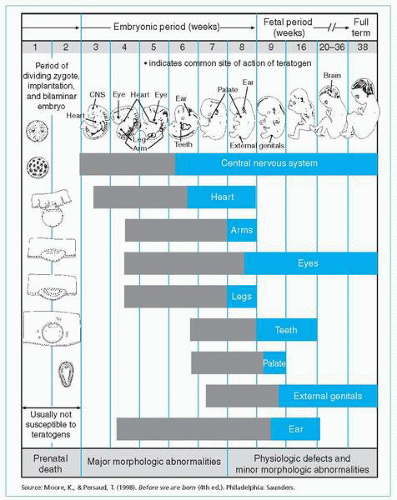Conception to Birth
The first 2 weeks are the germinal period.
For the first 8 weeks, the new organism is called an embryo.
Organogenesis is 95% complete by week 8.
Fetus is the name given to the prenatal human organism from 2 months to birth.
TERMS
Blastocyst
Ectoderm
Embryo
Endoderm
Fetus
Germinal period
Lanugo
Mesoderm
Morula
Myelination
Nidation
Organogenesis
Trophoblast
Vernix caseosa
Understanding prenatal development (Figure 13-1) is important for two reasons. First, the developing organism is open to environmental influences over a period of 40 weeks. The timing and nature of these influences can permanently alter the development of the fetus. Second, how development occurs prior to birth gives us information about development after birth.
Embryo is the name given to the fertilized ovum during the first 8 weeks of prenatal development. The first 2 weeks are also called the germinal period. From 3 to 8 weeks is the critical period of organogenesis, during which all of the major organs develop.
Germinal Period: 0-2 Weeks
0-40 hours: The fertilized ovum is called the zygote and consists of two to four cells. It rests in the fallopian tube.
40-72 hours: Having grown to 12 to 16 cells, the morula floats into the uterus and grows to 64 cells.
4-8 days: The blastocyst continues to grow to more than 100 cells. The inner cell mass becomes the human organism itself. The trophoblast forms between the inner mass and the environment; it will later develop into the placenta. By day 6 or 7, the blastocyst implants on the uterine wall, i.e., endometrium, in a process called nidation.
8-13 days: Cells separate and arrange themselves into three embryonic germ layers, which give rise to all of the major organs. The ectoderm—the outer layer—gives rise to the nervous system (including the brain and spine), skin, nails, hair, and salivary, pituitary, and mammary glands. The endoderm—the innermost layer—gives rise to the thyroid, bladder, lungs, and digestive system. The mesoderm—which emerges between the ectoderm and the endoderm—gives rise to the heart, circulatory and lymph systems, connective tissue, muscle, and bones. By the end of the 2nd week, the placenta, umbilical cord, and amniotic sac have taken shape.
Period of the Embryo: 3-8 Weeks
Third week: An indentation of cells, called the neural plate, forms in the ectoderm, giving rise to the brain (hindbrain, midbrain, forebrain) and neural tube (spinal cord). The chambers of the heart and blood vessels arise from a similar process in the mesoderm.
Fourth week: The heart begins to beat. Limb buds are visible. Eyes, ears, nerves, and the skeletomuscular and digestive systems begin to form. Vertebrae are present; major veins and arteries are completed. The neural tube closes. The embryo is approximately 0.5 cm long and weighs 0.4 g.
Stay updated, free articles. Join our Telegram channel

Full access? Get Clinical Tree




